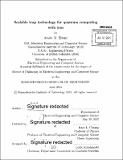Scalable trap technology for quantum computing with ions
Author(s)
Eltony, Amira M. (Amira Madeleine)
DownloadFull printable version (25.13Mb)
Other Contributors
Massachusetts Institute of Technology. Department of Electrical Engineering and Computer Science.
Advisor
Isaac L. Chuang.
Terms of use
Metadata
Show full item recordAbstract
Quantum computers employ quantum mechanical effects, such as superposition and entanglement, to process information in a distinctive way, with advantages for simulation and for new, and in some cases more-efficient algorithms. A quantum bit is a two-level quantum system, such as the electronic or spin state of a trapped atomic ion. Physics experiments with single atomic ions acting as "quantum bits" have demonstrated many of the ingredients for a quantum computer. But to perform useful computations these experimental systems will need to be vastly scaled-up. Our goal is to engineer systems for large-scale quantum computation with trapped ions. Building on established techniques of microfabrication, we create ion traps incorporating exotic materials and devices, and we investigate how quantum algorithms can be efficiently mapped onto physical trap hardware. An existing apparatus built around a bath cryostat is modified for characterization of novel ion traps and devices at cryogenic temperatures (4 K and 77 K). We demonstrate an ion trap on a transparent chip with an integrated photodetector, which allows for scalable, efficient state detection of a quantum bit. To understand and better control electric field noise (which limits gate fidelities), we experiment with coating trap electrodes in graphene. We develop traps compatible with standard CMOS manufacturing to leverage the precision and scale of this platform, and we design a Single Instruction Multiple Data (SIMD) algorithm for implementing the QFT using a distributed array of ion chains. Lastly, we explore how to bring it all together to create an integrated trap module from which a scalable architecture can be assembled.
Description
Thesis: Ph. D., Massachusetts Institute of Technology, Department of Electrical Engineering and Computer Science, 2015. Cataloged from PDF version of thesis. Includes bibliographical references (pages [187]-214).
Date issued
2015Department
Massachusetts Institute of Technology. Department of Electrical Engineering and Computer SciencePublisher
Massachusetts Institute of Technology
Keywords
Electrical Engineering and Computer Science.